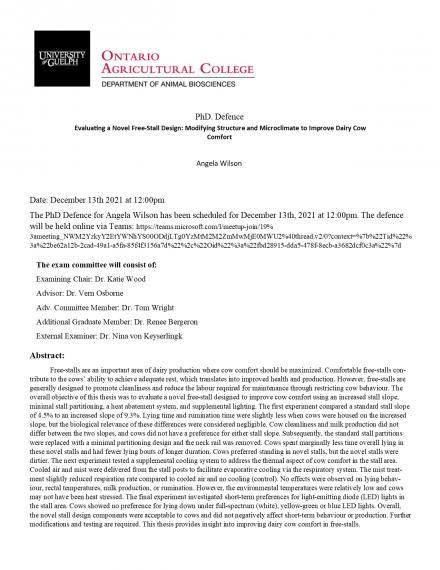Angela Wilson's PhD Defence
Date and Time
Location
https://teams.microsoft.com/l/meetup-join/19%3ameeting_NWM2YzkyY2EtYWNhYS00ODdjLTg0YzMtM2M2ZmMwMjE0MWU2%40thread.v2/0?context=%7b%22Tid%22%3a%22be62a12b-2cad-49a1-a5fa-85f4f3156a7d%22%2c%22Oid%22%3a%22fbd28915-dda5-478f-8ecb-a3682dcf0c3a%22%7d

Details
Free-stalls are an important area of dairy production where cow comfort should be maximized. Comfortable free-stalls con-tribute to the cows’ ability to achieve adequate rest, which translates into improved health and production. However, free-stalls are generally designed to promote cleanliness and reduce the labour required for maintenance through restricting cow behaviour. The overall objective of this thesis was to evaluate a novel free-stall designed to improve cow comfort using an increased stall slope, minimal stall partitioning, a heat abatement system, and supplemental lighting. The first experiment compared a standard stall slope of 4.5% to an increased slope of 9.3%. Lying time and rumination time were slightly less when cows were housed on the increased slope, but the biological relevance of these differences were considered negligible. Cow cleanliness and milk production did not differ between the two slopes, and cows did not have a preference for either stall slope. Subsequently, the standard stall partitions were replaced with a minimal partitioning design and the neck rail was removed. Cows spent marginally less time overall lying in these novel stalls and had fewer lying bouts of longer duration. Cows preferred standing in novel stalls, but the novel stalls were dirtier. The next experiment tested a supplemental cooling system to address the thermal aspect of cow comfort in the stall area. Cooled air and mist were delivered from the stall posts to facilitate evaporative cooling via the respiratory system. The mist treat-ment slightly reduced respiration rate compared to cooled air and no cooling (control). No effects were observed on lying behav-iour, rectal temperatures, milk production, or rumination. However, the environmental temperatures were relatively low and cows may not have been heat stressed. The final experiment investigated short-term preferences for light-emitting diode (LED) lights in the stall area. Cows showed no preference for lying down under full-spectrum (white), yellow-green or blue LED lights. Overall, the novel stall design components were acceptable to cows and did not negatively affect short-term behaviour or production. Further modifications and testing are required. This thesis provides insight into improving dairy cow comfort in free-stalls.